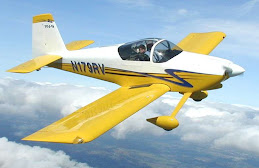Thursday 28th August 2008. 4hr 40min.
Found problem with main rib placement and corrected it. Assembled and riveted main wings to right spar. Riveted right aft spar assembly to main ribs.
With a clear mind, the problem with the main ribs soon became obvious. As I suspected, I had indeed allowed some ribs to be exchanged between the left and right wing sets. However, this had happened at the first assembly stage, so they had been marked as belonging to the wrong set and this was what had confused me yesterday evening. The ribs involved are the three ribs that are tightly spaced under the wing-walk doublers, immediately next to the inboard rib. The inboard rib and the three which follow it should all have their flanges pointing inboard, whereas I had these 3 pointing outboard. A look at the high-res version of the photo of the fully assembled wing skeleton (with bottom skin) that I took a while back confirmed that the orientation was wrong.
So this was easy to fix by swapping the affected ribs between right and left wings. Of course, this means that these ribs have been match-drilled to the wrong spars, skins and stringers. However, I see lots of forum entries on the subject of match-drilling replacement fuselage or wings skins and the conclusion seems to be that holes can be simply drilled out to full size without being assembled to the frames and adjoining skins. The kit seems to be so accurate that match-drilling is somewhat superfluous. Because of this, I fully expect that the ribs will match up with everything else without any problems. We will see, but there was no way I was going to leave them facing the wrong way as it would have made the riveting of the bottom skins very difficult.
So, problem solved (sort of) and on to the riveting. This was easier than I thought it would be. I used Smitty's set up and method, taking out one rib ahead of the one being riveted in order to allow easy access to both sides of the spar at the point being riveted. One thing to watch out for here is that the tip rib is riveted in assembly with the tip rib of the leading edge assembly so it can't be done at this stage - I left it clecoed to the spar. However, I think the aft end of this rib can be riveted to the aft spar and doubler.
The solid reinforcing bars on the forward side of the spar make it a little awkward to set the top and bottom rivet on each rib, particularly at the point where the bar is about the same height as the unset rivet. I switched from my biggest mushroom bucking bar to a rectangular-faced bar for these, so that I was not riveting on the edge of the circular-faced mushroom set. I had also protected the reinforcing bars with medical tape. I used the 1/8 double-offset set in the rivet gun and taped it to the gun with duct tape to keep it from rotating and to keep the gun from scratching the primer on the ribs. With the aft end of each rib still unattached, it was easy to move the rib aside to get a straight shot, so I am not convinced that the double offset rivet set was strictly necessary. I did have to use plenty of clecos, however to ensure that the flange of the rib stayed flush against the spar, while bending the rib out of the way.
Riveting on the aft spar was another job for the air squeezer, this time with the longeron yoke. I had to be careful that the aft flange of each rib was clecoed in its correct place as there are a number of places where it is easy to be confused. Careful attention to rivet sizes and types is also essential here. I decided to go up and down the spar finishing off each size of rivet before going on to the next size because otherwise I would have had to change the gap between sets literally dozens of times during the job.





















































